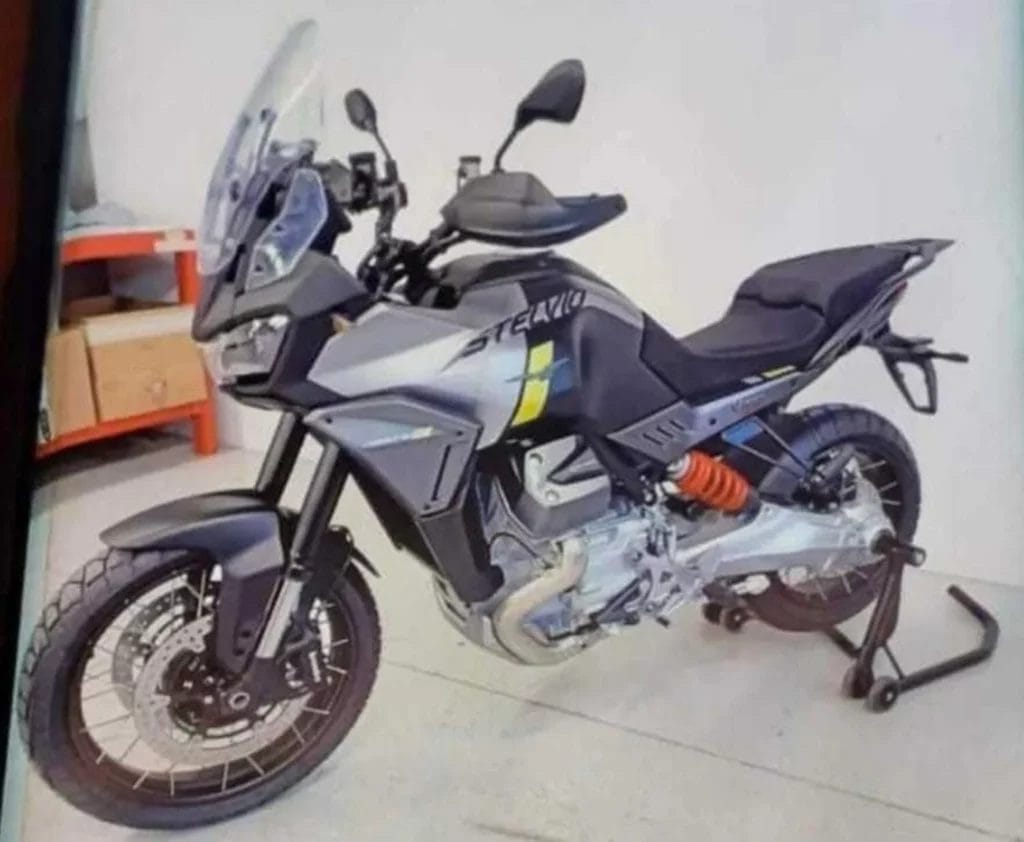This is what the new Moto Guzzi V100 Stelvio will look like In fact, Gruppo Guzzisti Italiani has published photos of the Stelvio on Facebook, complete with the definitive graphics, probably “stolen” from Mandello’s headquarters or from an external supplier. We can also see two colors for the Stelvio: an elegant grey/black and a sportier grey/yellow.
We’ve already been able to show you the Stelvio in action, through photographs of the model being tested by Moto Guzzi. This is a novelty announced (at the last EICMA) and eagerly awaited by fans of the manufacturer from Mandello del Lario.
The engine and frame are the same as those used in the V100 Mandello, which will make up the new maxi family. To begin with, we hope to see an enduro roadster in the future, heir to the Stelvio, but also a sports car that could perhaps bring the Le Mans name back into the limelight, and then a real roadster. Finally, a V2 of this type could also be adapted to other models – read cruiser – and we believe it could increase the engine capacity, if necessary, in the future.

But let’s stick to today, which already gives us a good idea of the direction Moto Guzzi has taken. After discontinuing the 1200 eight-valve engine at the end of 2016 due to the advent of Euro4 regulations, and then with the arrival of Euro5, only models equipped with the 853 cc air-cooled V2 remained in the Guzzi range: V7, V9 and V85TT.
The arrival of a new engine was essential to bring the range of new bikes up to speed with the times. And this happened with the V100 Mandello, which was then exhibited at EICMA 2021. The following year, the Lombardy show announced the arrival of the Stelvio. And now here we are, testing has progressed and it’s only a matter of a few months before we see the Stelvio in dealerships.
The engine capacity is 1,042 cc (bore and stroke 96×72 mm), with liquid cooling.

The cylinder heads are rotated by 90° (as on the latest BMW boxer 1200 and 1250) to position the intake more appropriately and leave more legroom for the rider.
Another novelty on the Guzzi is the adoption of a countershaft that doesn’t serve to balance the first-order forces, but rather to compensate for the reverse torque typical of engines with a longitudinal crankshaft. This has made it possible to have a shorter and lighter crankshaft, so that the length of this V2 is 103 mm shorter than the Small Block of the V85TT, it weighs less than the 1200 8V, has less inertia and has earned the name Compact Block.
It has wet sump lubrication and the oil sump is separated by a reed valve, so it becomes less tall and the engine can be positioned lower, still leaving room for the exhaust system. The clutch is a wet multi-plate type and the gearbox is six-speed.
As far as performance is concerned, power is 115 hp at 8,700 rpm, with the limiter cut at 9,500: that’s 110 hp/liter. For comparison, the current 853 cc V2 has 89 hp/liter.
Maximum torque is declared at 10.7 kgm at 6,750 rpm and routine maintenance is scheduled for every 12,000 km (Mandello data).
The V100 also marks the debut on Mandello bikes of a refined electronic management system based on Marelli’s six-axis IMU inertial platform.

On the Mandello, there are four riding modes (Turismo, Rain, Strada and Sport, all at full power) and each is combined with three engine maps (i.e. throttle response), four levels of traction control and two levels of engine brake. In the Stelvio it is conceivable that there will be an additional map for off-road use, while from the photographs we can guess the presence of a front radar, useful for equipping the adaptive cruise control.
Two versions are expected. A basic one, with manually adjustable suspension, and a top-of-the-range one with semi-active electronic suspension. Once again, the suspension will have more travel than the Mandello, around 200 mm. The wheels are spoked with 19- and 17-inch rims, fitted with tubeless wheels. The braking system, given the advanced electronics of the new Moto Guzzi platform, will certainly feature Cornering ABS.







